Frozen in Time (22 page)

This important discovery begged the question: Why had the surgeon conducted an autopsy? To ï¬nd out the cause of death, obviously; but what had prompted the decision? Perhaps the death of John Torrington of the
Terror
only three days before was part of the reason. There may also have been some symptoms associated with Hartnell's death that left serious doubt in the minds of the surgeons as to the cause of death. A challenge faced Amy, who had to sort through the riddle.
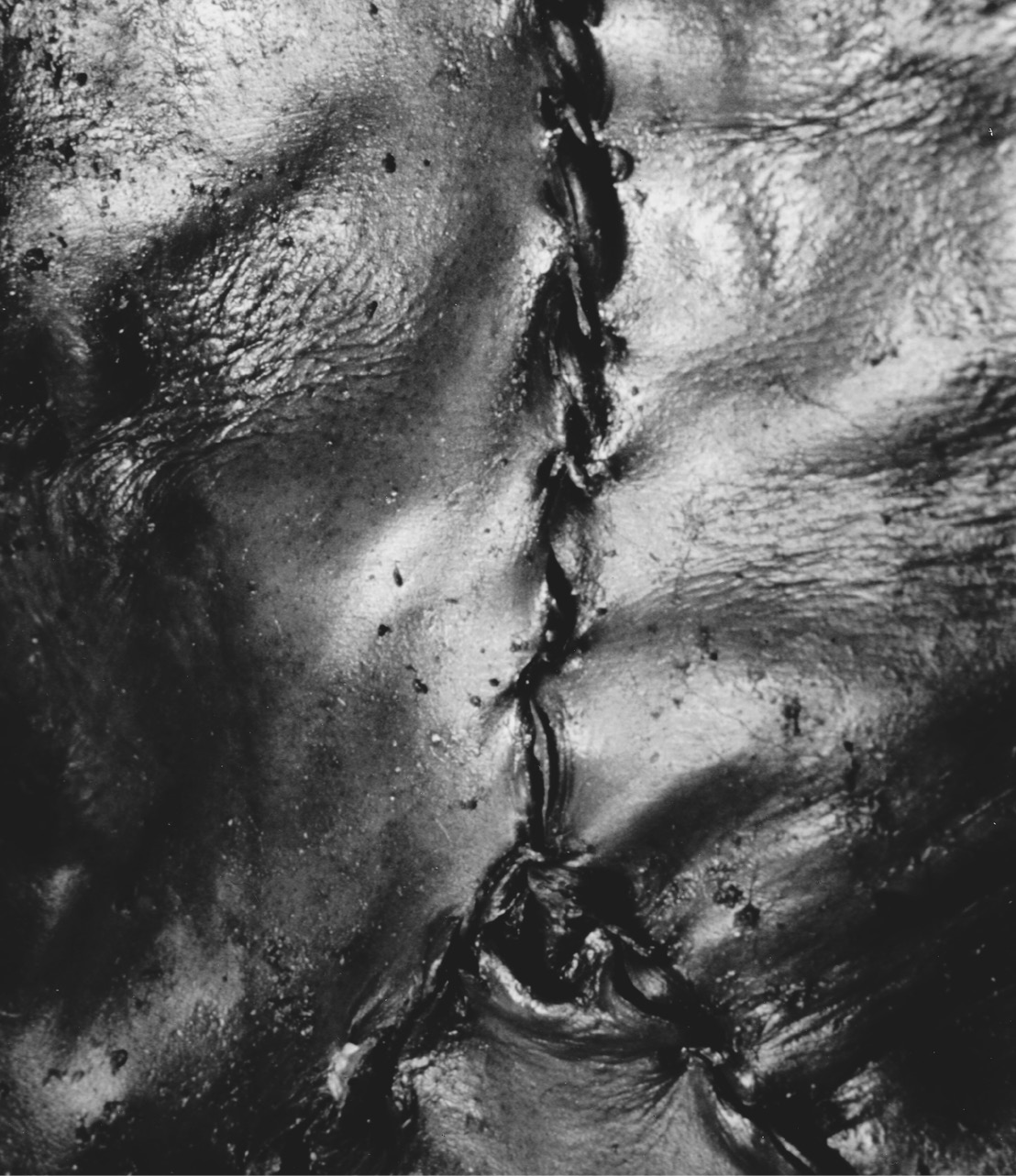
The sutured autopsy incision found on John Hartnell, dating to the autopsy conducted on his body during the expedition in early January 1846.
The standard incision in an autopsy performed today is “Y”-shaped, with the arms of the “Y” extending down from each shoulder and meeting at the base of the sternum (breastbone). From this point, the incision continues down to the pubic bone. In the case of Hartnell's autopsy, however, the incision was upside down: the arm of the “Y” originated near the point of each hip, meeting near the umbilicus (belly button) and extending up to the top of the sternum. Given that the procedures for autopsy technique in the mid-nineteenth century are not well represented in today's scientiï¬c literature, Beattie wondered if the incision indicated that the surgeon was concentrating on the bowel or whether this was the habitual procedure for autopsy followed by the surgeon. Amy was later able to reconstruct, step by step, what the original pathologist had done. The extent and direction taken during this ï¬rst autopsy would provide clues to the suspicions held by the surgeon relating to the cause of death.
That an autopsy had been done solved the mystery of the strange X-rays: the surgeon of the
Erebus
had removed the organs for examination, then replaced them in one mixed mass. Not surprisingly, this disrupted anatomy resulted in a meaningless collection of soft-tissue detail in the ï¬rst X-rays taken by Notman and Anderson. Also, the brownish discolouration seen in the ice when the lid was ï¬rst removed probably resulted from blood and other ï¬uids seeping out of the incision when water ï¬lled the coffin during the summer of 1846.
After Notman and Anderson had completed a second series of X-rays, a process that took another six hours (for a total of fourteen hours of X-raying), they retired for a well-deserved rest, but not before a slightly hair-raising experience. The X-raying had continued into the late hours, and most of the crew had retired to their tents. Savelle and Nungaq were sitting in the kitchen tent talking. Beattie was in the autopsy/X-ray tent, more as company for Notman and Anderson than as help. Keena, the dog brought along to serve as a watch for polar bears, was tethered outside the kitchen tent and could be heard whining in her familiar, annoying way. Suddenly Keena stopped whiningâunusual in itself. But then she barked madly. The three men in the autopsy/X-ray tent looked at each other. They had never heard her bark before and they knew that there had to be a good reason: a bear. Then they heard the “pop pop pop” of riï¬es being ï¬red and, off in the distance, voices shouting, “Bear, bear in camp!” Beattie reached for the riï¬e he had brought down to the tent and slowly stuck his head out. The tents over the graves and the autopsy/X-ray tent were separated from the main grouping by about 330 feet (100 metres), and, peering round the edge of Braine's tent back towards the main camp, he saw a bear standing in the open space. Notman and Anderson were now beside Beattie, sizing up the situation. Beattie had Kowal's gun, one with which he was not familiarâand sure enough the bolt jammed twice, but the third and ï¬nal bullet went into the chamber cleanly. Notman, looking around for some other weapon, grabbed a shovel. Anderson had his camera. So armed, the three stayed behind Braine's tent out of sight of the bear, which soon became annoyed at the noise of guns and people. It ambled off, angling towards the beach. Passing downwind of the graves, just 65 feet (20 metres) away, it then caught the scent of the three and of John Hartnell. As it paused with its nose in the air, Beattie thought, “Oh, brother, it's gonna come this way.” But then he heard “twang twang twang,” as three bullets ricocheted off the gravel beside the bear, forcing it back in slow retreat, and the crisis ended as the bear ambled down the beach and out onto the ice. From that point on during the summer, someone always stayed outside keeping watch with the dog. From the bear tracks in the snow, Nungaq was able to determine that it had come in off the ice close to the kitchen tent, chased some gulls, wandered up to the food cache beside the kitchen tent and then saw the dog and decided to sniff it out. No wonder Keena had barked: when people started to pop their heads out of tents to see what the commotion was all about, the bear and the dog were nose to nose. Keena was lucky. Notman, Anderson and Beattie were lucky. It may have been close to the end of a long day, but none of the crew was ready for sleep now.
With the X-raying complete, Amy and Beattie, dressed in green surgical gowns, white aprons and blue surgical caps, began the autopsy. Hartnell was ï¬rst measured and weighed. He was taller and heavier than Torrington, at 5 feet 11 inches (180 cm) and 99 pounds (45 kg). Amy then reopened the inverted “Y” incision by cutting the original sutures. He noted that several knife cuts were made on the surface of the chest plate before the ribs had been successfully divided during the original autopsy. It soon became obvious that Franklin's surgeons had not focussed their attention on the bowel, as their incision suggested; it seemed they believed the cause of Hartnell's death concerned the heart and lungs. In the earlier autopsy, Dr. Goodsir had removed the heart with part of the trachea. He would ï¬rst have held the heart up to look at its apex for signs of disease; then he made two cuts, one each into the right and left ventricles, to look at the valves. When he had ï¬nished with the heart, he dissected the roots of the lungs to look for evidence of tuberculosis and made a few cuts into the liver looking for con-ï¬rmation of the disease. Hartnell's bowel was untouched. On completion of the autopsy, Dr. Goodsir replaced Hartnell's chest plate (the anterior portion of the ribs and the sternum) upside down. The original autopsy turned out to have been a cursory one that could have been conducted in less than half an hour. During his investigations, the surgeon of the
Erebus
would have found conï¬rmation of tuberculosis of the lungs. Once observations about the original autopsy had been completed, Amy began his own much more detailed investigation. Beattie labelled the sample containers and sealed the samples handed to him by Amy, while Spenceley photographed the proceedings.
First, any frozen water from inside the body was collected, as these ï¬uids would have come from the tissues. Then, after sterilizing his surgical instruments in the open ï¬ame of a naphtha stove, Amy cut a frozen piece from each of the organs and placed these samples in a sterile container that was promptly sealed and kept frozen in a cooler. The samples would later undergo bacteriological analysis in the laboratory. Other samples of organs and tissue were then taken and placed in preservative, to be later studied under a microscope. Amy occasionally made observations about the condition of Hartnell, such as the state of blood vessels: “Vessels don't contain blood, they contain ice and the ice is clear.” Many of the organs were found to be in a fair state of preservation, though the brain had turned to liquid. Finally, bone was cut with a surgical saw from the femur, rib, lumbar vertebra and skull. From start to ï¬nish, when Amy resutured the original 1846 incision, the autopsy took the three men nine hours to complete. It had been very thorough.
Everyone was exhausted, yet work was continuing nearby in Braine's tent in preparation for his exposure. Hartnell's body was tightly wrapped in the autopsy sheet and carried into his own tent. When Schweger ï¬nished documenting the Hartnell fabrics, the group arranged for his reburial. The blanket was repositioned in the bottom of the coffin and the original shroud laid back in position. His body was passed down into the grave and placed in the coffin. The shroud was then closed over him, and it was soon time for their ï¬nal moment with the young sailor.
Just before midnight on 18 June, they all gathered in Hartnell's tent. Schweger had brought the clothingâwrapped in mylar, an inert material that would protect the clothes. Spenceley and Beattie jumped down into the grave, and Schweger passed them each item of clothing, which they placed carefully alongside the shrouded body. Once this was complete, the lid was lowered down, but, as they tried positioning it on the coffin, the two men could not get it to ï¬t as they had found itâa layer of ice had formed on the top edge of the coffin, and this had to be chipped away before the lid would fall into its proper place. Beattie took the small chisel hammer and removed the ice within a few minutes, and the reburial continued. Spenceley and Beattie, helped out of the grave by the others, now joined the ring of researchers standing at the graveside. A spontaneous moment of silence was punctuated by the sound of the wind snapping the tent ï¬aps and the sorrowful howling of Keena. “One hundred and forty years ago, his brother was standing in this same spot,” Beattie said at last, breaking the silence.
Slowly, the group ï¬led out of the tent and, with hardly a word spoken, they all began to ï¬ll buckets with gravel and complete the process of reburial. At this time, none of them could fail to feel the transience of human existence and the reality of death. Exhuming Hartnell had been a hard thing to do, something very difficult to deal with. But now it was ï¬nished and, for the moment, there was relief that this one door was closing on their project. But in the tent next to them, the excavation of Private William Braine of the Royal Marines had already uncovered a surprise.
As with torrington and Hartnell's graves, a string grid was placed over Braine's grave. Damkjar made scale drawings of the surface features in each square of the grid, while Spenceley, hovering on a ladder over his tripod-mounted camera, took a series of Polaroid photographs to be used during the reconstruction.
On the snow beside the grave, the crew assembled another long-house tent. This was lifted over the headboard and positioned over the grave, allowing some manoeuvring space at each side of the structure. The tent was then tied to Hartnell's tent and the corners secured to large metal pegs driven into the permafrost.
The gravel covering the grave and ï¬lling the spaces between the limestone rocks was removed by trowelling, and, during this cleaning process, a few artefacts were found that had, over the decades, worked their way into the cracks and corners of the grave. The exact positions of these objects, mainly wood fragments and bird bones, were recorded in reference to the string grid that still covered the grave. One of the large, slab-like limestone rocks was covered with a mat of gravel consolidated by a well-established colony of mosses, and the crew did not disturb this tiny islet of vegetation. They lifted the huge rock so that the eventual reconstruction of the grave would include the micro-garden.
One of the distinctive features of Braine's grave was the highly structured nature of its surface features. The overall impression was that it represented a crypt, and the detail of parts of the structure seemed to conï¬rm this. A major challenge to the excavators would be the accurate reconstruction of the grave. So the rocks were removed, identiï¬cation numbers and orientation indicators were penned on their undersides. These were then carried outside the tent and placed in rows on the snow, the larger rocks being used as anchoring weights for the edge of the tent.
Two hours were spent in identifying and removing nearly one hundred rocks from the surface of the grave. One of the more interesting of the large rocks was the roughly circular slab lying on the surface at the foot of the grave. Two-thirds of the exposed surface had a black colouration, which Savelle said had been applied to the grave by Penny in 1853â54. When the rock was upended, they saw that the underside was nearly completely painted black. It was apparent that this rock had at one time been standing at the foot of the grave and had functioned as the footboard seen in some of the engravings and paintings made at the site during the 1850s.
The next step, after all the rocks had been removed, was to begin the now familiar task of removing the permafrost. Kowal, Carlson, Savelle and Nungaq began digging and, eighteen hours later, encountered the ï¬rst signs of Braine's coffin. The excavation of Braine's grave exempliï¬ed the determination of the crew, as they worked virtually non-stop for a total of 37 hours until the goal had been reached and the coffin completely exposed. Braine had been buried very deeply, down 6a feet (2 metres) in the permafrost, and his coffin turned out to be the largest of the threeâ 82 by 19 by 13 inches (211 by 49 by 33 cm) deep. This combination resulted in the removal of considerably more permafrost than from either Torrington or Hartnell's graves: all four sides of Braine's grave excavation had to be extended as the size of the coffin became obvious.
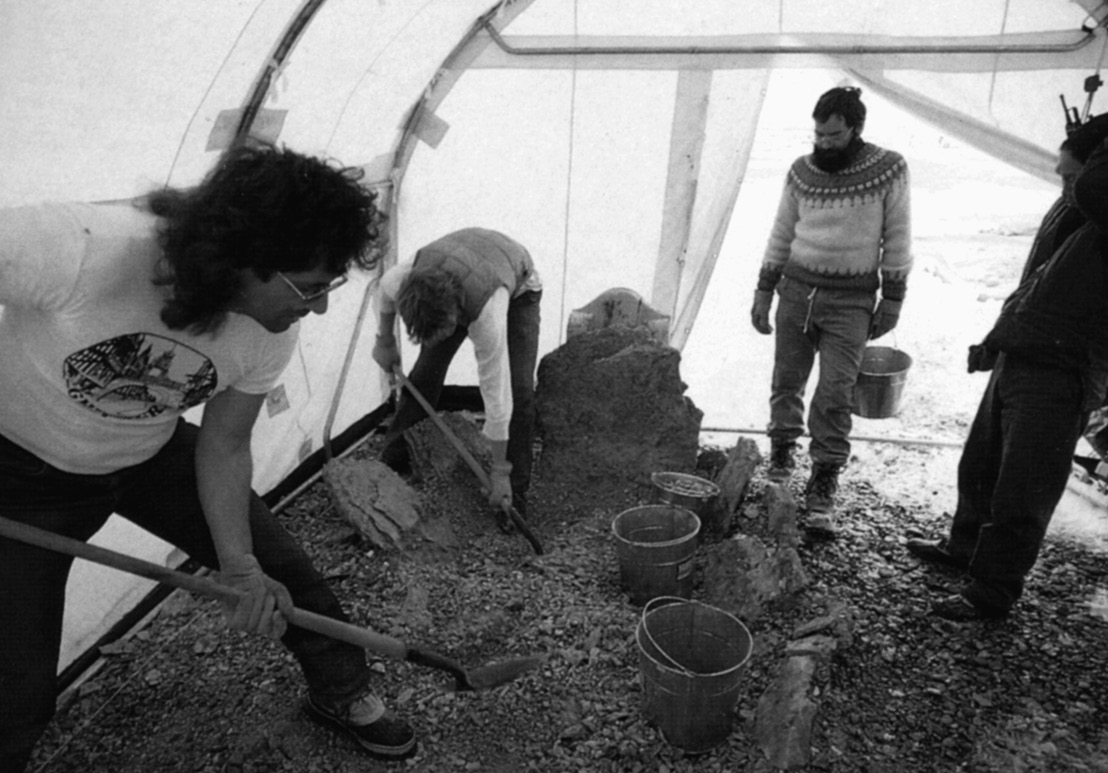
Beginning the excavation of William Braine's grave. Left to right are Walt Kowal, Arne Carlson, Jim Savelle and Joelee Nungaq.
As the ï¬nal inches of permafrost were picked away, the texture softened, signalling the approach of the coffin. Aware that both Torrington and Hartnell had been buried with plaques attached to their coffin lids, Kowal explored carefully the position on the lid where a plaque would have been placed. One of the thrills of archaeology is that discoveries, even those that are predictable because of previous experience, are invariably a surprise. The discovery of Braine's plaque was no exception: the ï¬rst, small exposure of the plaque revealed its completely unexpected appearance. It was copper-coloured and, as the exposure was enlarged, Kowal could see that it was metal, with the green-blue patina of copper oxidation showing on the small portion of the edge that had been carefully exposed. Kowal continued to widen the window over the plaque, which seemed to be extensive. The words punched into the metal began to emerge, and eventually the whole plaque was uncovered. It was huge, 13 by 17 inches (33 by 44 cm), and great care had obviously been taken in its preparation. The plaque read: “W. BRAINE R.M. 8 CO. W.D. H.M.S. EREBUS DIED APRIL 3RD 1846 AGED 33 YEARS.”
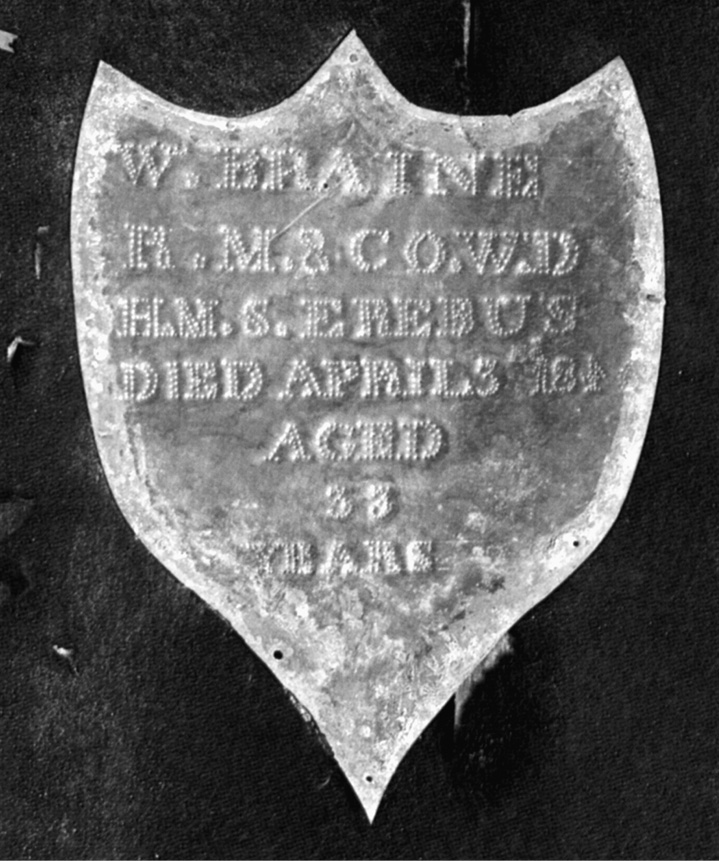
The copper plaque found nailed to William Braine's coffin lid. It reads: “W. Braine / R.M. 8 Co. W.D. / H.M.S. Erebus / Died April 3rd 1846 / Aged 33 years.”
The “4” in 1846 was backwards. Everyone was thrilled by the preservation and quality of the plaque, which, while constructed differently from Torrington's, was just as touching. With a lot of digging still to do, the plaque was covered by a piece of plastic and a thin layer of gravel to protect it during the continuing exposure of the whole coffin.
The coffin lid appeared to be in excellent condition, and Carlson felt that he could remove the lid without shearing the nails, but instead by carefully prying it with a crowbar. He began slowly, but the nails pulled free quickly and within twenty minutes the lid was loose and ready to be lifted. Carlson and Beattie, one at each end, lifted the lid slowly and gently straight up, supporting it on their arms as they passed it up to Nungaq and Damkjar, who immediately took it out of the tent.
“I see some bright red,” said Carlson, as all the researchers peered at an area of blood-red ice covering Braine's face. Beattie glanced along the length of the coffin. He could see part of a shroud over the chest area. In direct contact with the coffin lid, it had not been obscured by the opaque ice that ï¬lled the rest of the coffin. When the thawing was started, the red colour over Braine's face quickly took on texture and shape. It was a kerchief of Asian design with a pattern of leaves printed in black and white. As the ice melted in the rest of the coffin, the outline of the whole shroud was soon determined.
Within a few hours, the upper half of the enshrouded body was exposed. It was the most arresting vision the researchers had experienced at the site. The outline and contours of the body could be perceived in the ivory coloured shroud, but the sight was dominated by the bright red kerchief lying over Braine's face. The vivid colour seemed so out of place deep within the grave, and the ï¬lmy nature of the material caused it to cling tightly to the face it covered, accentuating the outlines of Braine's brow, nose, chin and cheeks; in the centre, behind small tears in the kerchief, the black oval of his partly opened mouth was visible. Poking through the tears were some incisor teeth, producing a frightening, scarlet grin that left every one of the crew transï¬xed.
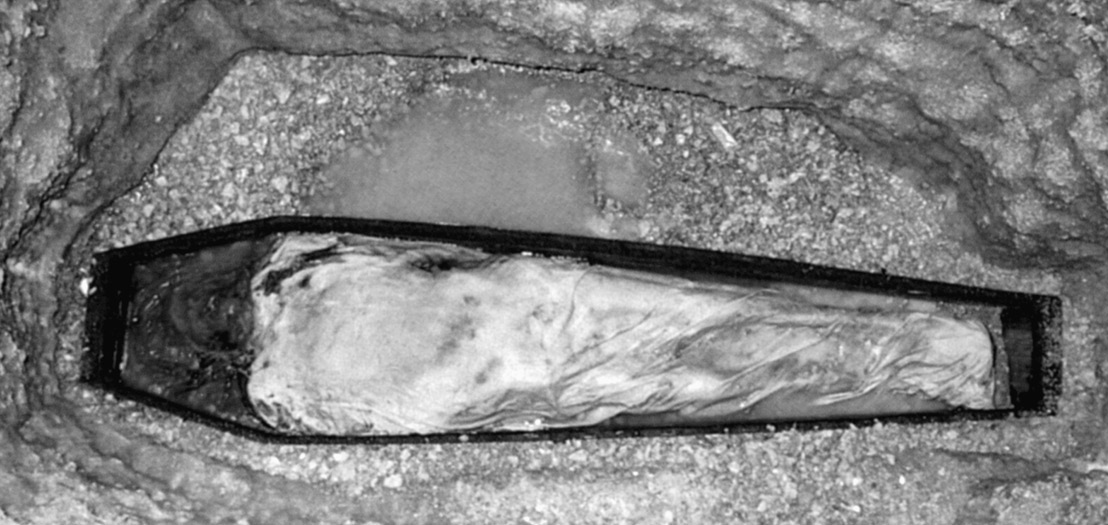
William Braine's shrouded body, his face covered by a red kerchief.
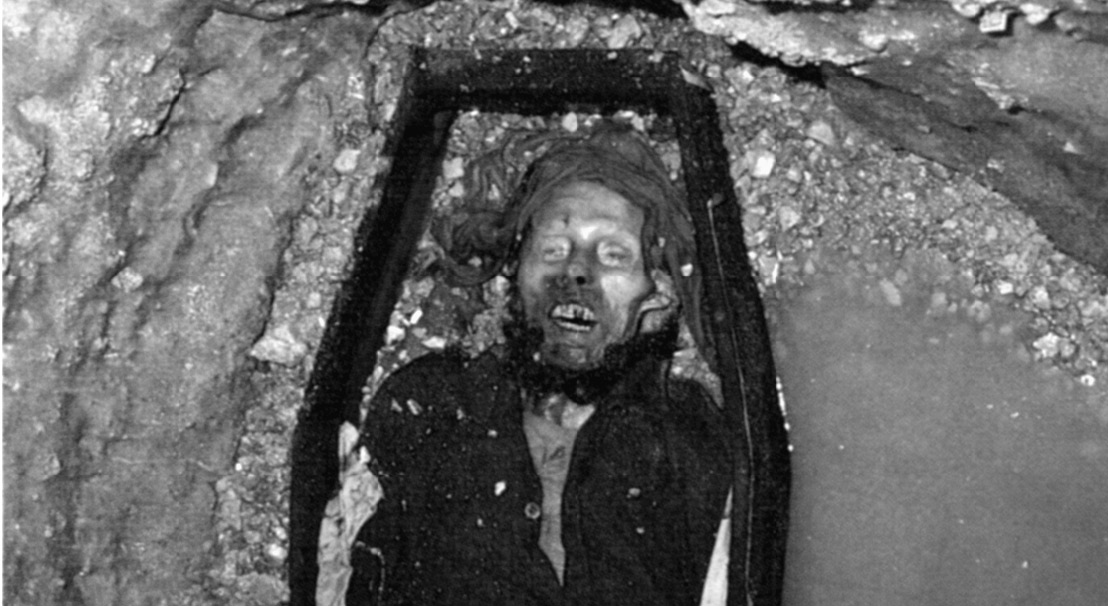
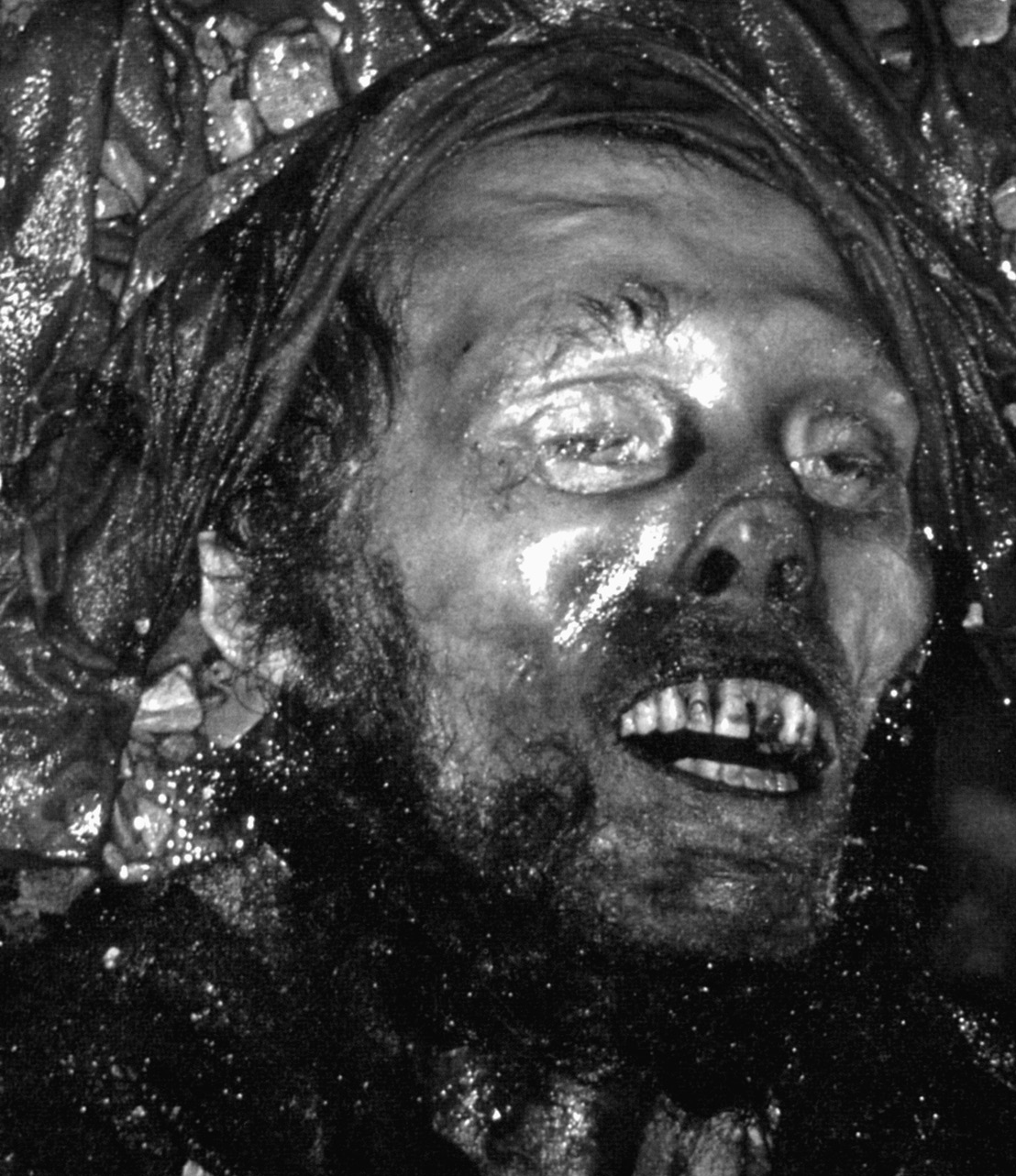
The kerchief is drawn back to reveal Braine's face.
The edges of the kerchief were still frozen deep in the recesses of the coffin; it was not yet possible to remove it to reveal Braine's face. By pouring water into the corners of the coffin, the material slowly loosened and could be partly rolled back. As it was retracted, the face took on character and an identity.
By now, the team had been working for sixteen hours without rest. Beattie, aided by Damkjar, described the scene to the others as it became visible to him: “There's a beard, curly and dark⦠got to be careful. There are the teeth, there's an ear. It looks like he's balding a bit.” Then Beattie stepped back to take in the view of a man who appeared severe and life-toughened, very much a nineteenth-century Royal Marine private. “Look at that. After a long day's work it's really something to see,” he said quietly, as if to himself.
Braine's teeth were in very bad condition and one of his front teeth had been broken in life, causing the exposure of the pulp cavity. His lips, unlike Hartnell or Torrington's, were pulled tightly over his teethâperhaps the kerchief had prevented the lips from curling outwards. His nose was slightly ï¬attened. He would have stood nearly 6 feet (181 cm) tall, and the large coffin seemed too small for him. When he had been originally placed in the coffin and the lid attached for the ï¬rst time, it had pressed down onto his nose.
His eyes were deeply sunk into the eye sockets and were only one-quarter open. The eyeballs did not appear to be very well-preserved but he still had a sleepy, nearly alive appearance. A scar on his forehead indicated that he had been struck or had cracked his head against an object several years before his death. Finally, it was possible to remove the rest of the kerchief from the face, and they saw that his hair was nearly black, long and partly curly, and that he was indeed balding.
After pulling the shroud away, his shirt and right arm and hand were also exposed. “Look at that hand, it's very well-preserved,” Beattie said. “Nice shirt, there's not a mark on it, it looks brand new.” No sign of his left arm could be found, and the possibility that it may have been amputated was discussed. As thawing progressed, they discovered that his left arm was frozen underneath his body. Beattie at ï¬rst thought Braine had been too big to be placed in the coffin with his arms in their natural position. But they later saw that it would have been just as easy to have placed his arms over the sides of his chest and still have room for the coffin lid. His body and head, too, were not positioned carefully, and one of his undershirts had been put on backwards, leading them to conclude he was placed hastily in the coffin.
Thawing the body was again a matter of pouring warm water over the frozen sections. In the cold of the grave the warm water would send up clouds of steam ï¬lled with the pungent smells of wet wool and cotton. Hours of this smell took its toll on some of the crew and the emotional strain of the work drained them all. Braine, being buried so deeply, was in colder ground, and the ice would not yield without a battle. They had tremendous difficulty in thawing the portions of the clothing and shroud frozen to the bottom of the coffin, which trapped Braine within it. Warm water poured directly onto the material seemed to have little effect, and the team struggled for eighteen more hours before they were able to free him from the ice. Even then, they had to cut the clothing up the small portion of exposed back and lift him, not only out of the coffin, but out of his clothes as well. Beattie and Amy then eased him up to the side of the grave, handing him to Savelle and Kowal, who positioned him on a plastic sheet.
Immediately noticeable was the extremely emaciated appearance of this manâliterally a skin-covered skeleton. Braine would have weighed less than 88 pounds (40 kg). He must have been extremely ill during his ï¬nal days. Every rib could be counted and it was possible to identify features on his hip bones. His face also reï¬ected his condition, the skin drawn taut over the cheeks and eye sockets. His limbs had a spidery appearance; so thin were his arms that his hands appeared very large. For Beattie, lifting this frail and lifeless man up and out of his grave, coming as it did after such tremendous effort to free him, was the most difficult aspect of his work on Beechey Island. The strained faces of the others illustrated that he was not alone in these feelings.
Exhausted though the team was, Braine was immediately wrapped in a sheet and carried across to the X-ray tent. Notman and Anderson, who had been sleeping after their difficult work on Hartnell, were roused so they could begin their work. The X-raying of Braine was carried out much as it had been with Hartnell, though the situation was quite different as Braine had not had a previous autopsy. Both worked continuously for nearly twelve hours until the X-raying was completed.
Before the others could rest they still had to remove Braine's clothing from the coffin for Schweger to analyze. With the body removed, thawing accelerated and the job was completed in an hour. During the initial thawing of the foot-end of the grave, Carlson thought he detected a different kind of fabric peeking out just below the shroud-wrapped feet. Not until the body had been removed and further thawing of the shroud had taken place was his observation conï¬rmed. Rolled up and placed under Braine's feet were a pair of stockings. These were quite large and appeared to be of a heavy material, and one had a hole in it. The thawing and removal of the shroud and kerchief were left for the following day. Beattie, Kowal, Savelle, Amy and Damkjar wandered back to the cook tent, had a wash outside and went in for food and drink. They were then able to have a brief rest before returning to conduct the autopsy.
When they gathered again, all suffered terrible headaches and dizziness. Some felt they would be physically ill. They came to the conclusion that they were suffering the effects of carbon monoxide poisoning from the two stoves that burned continuously during the removal of Braine from his coffin. Although the tent ï¬ap had been tied open and a breeze had blown through during the work, the fumes had gathered in the grave pit, creating the problem.
When Amy and Beattie entered the X-ray/autopsy tent to begin their work, Notman pointed out a series of lesions on Braine's body: on the left and right shoulders, in the groin area and along the left chest wall. These lesions involved the skin and in some cases the tissue and muscle below. Close inspection revealed teeth marks. Notman and Amy agreed that rats must have attacked the body while it had rested aboard the
Erebus,
prior to burial.
Rats were a common problem on nineteenth-century ships and caused difficulties even among Arctic expeditions. Elisha Kent Kane, the United States Navy officer, had experienced severe problems with the vermin while commanding the
Advance
in the Franklin search from 1853 to 1855:
They are everywhere⦠under the stove, in the steward's lockers, in our cushions, about our beds. If I was asked what, after darkness and cold and scurvy, are the three besetting curses of our Arctic sojourn, I should say RATS, RATS, RATS.
⦠it became impossible to stow anything below decks. Furs, woollens, shoes, specimens of natural history, everything we disliked to lose, however little valuable to them, was gnawed into and destroyed.
Even efforts to fumigate the ship with the “vilest imaginable compounds of vapoursâbrimstone, burnt leather, and arsenic” failed to get rid of the rats.
Notman had compared the X-rays of Hartnell with those just taken of Braine and described one interesting difference to Beattie: “With Hartnell's skull we could not penetrate to see bony details with X-rays because of the solid block of ice inside. That's what is creating this uniform whiteness,” he said, pointing at the X-ray. “In contrast, Braine's skull could be penetrated quite easily. I really don't have any explanation for that because they were buried under similar circumstances.”
